Agronomic Insights
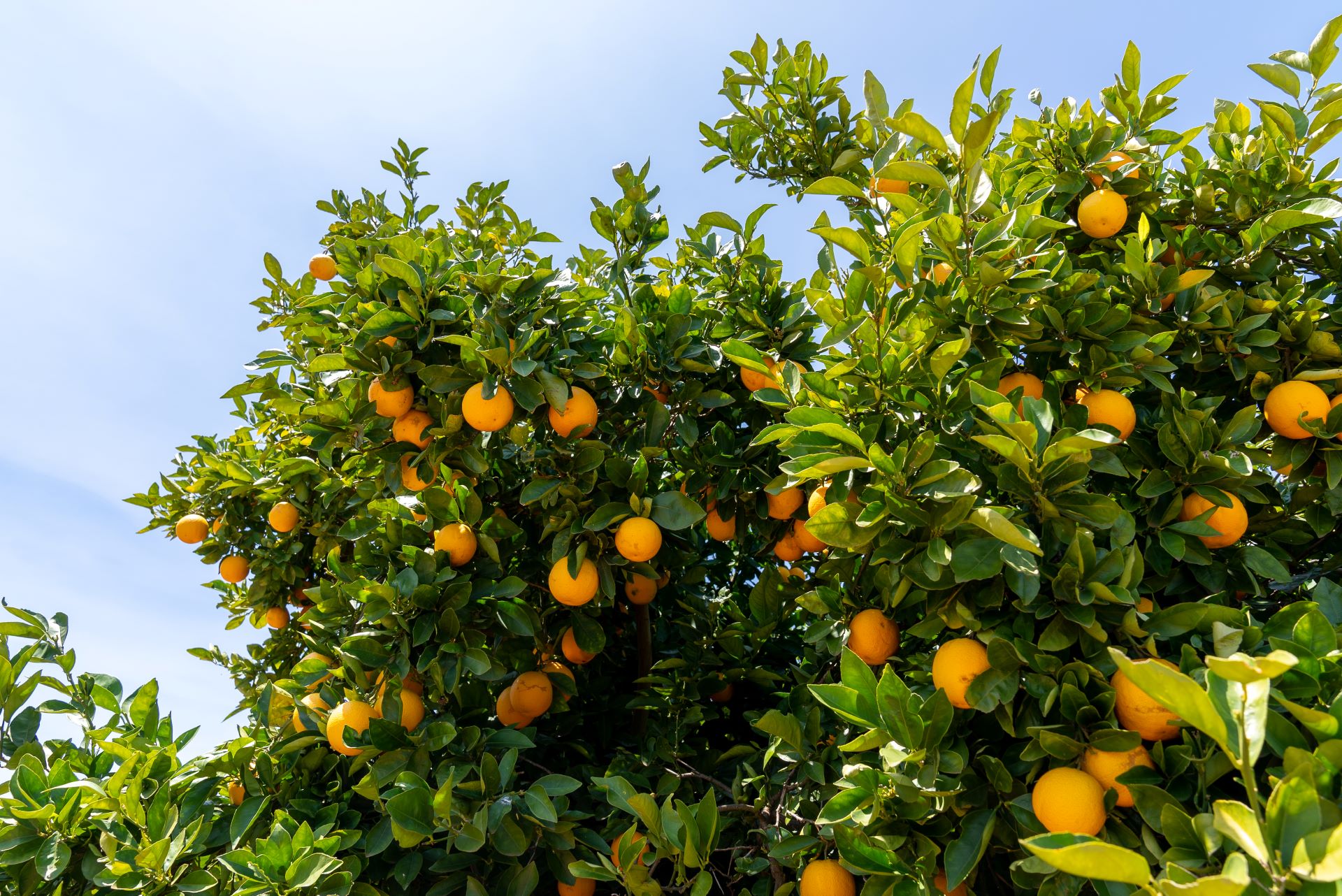
Natalia Gomez – IPF Farming Services Specialist
Citrus trees have a high demand for nutrients, so it is essential that the right fertilisers are applied at the right growth stages to avoid nutrient deficiencies and maintain tree health and productivity. Optimising citrus crop nutrition is important to maximise ROI from inputs and achieve quality fruit output.
Developing a Fertiliser Plan
Now is a great time to develop an annual fertiliser program for citrus trees. Fertiliser programs are generally calculated annually and revisited at set growth stages during the season to adjust as required. The best fertiliser programs are based on an understanding of the orchard and its recent management, including previous yields, soil and plant tissue test results and target yields.
Every orchard is different, so growers and their advisers are encouraged to carefully monitor nitrogen, phosphorus, potassium, magnesium, zinc, manganese, iron and copper. It is only by monitoring what is happening with soil tests and leaf tissue tests that you can hope to keep nutrient levels in the optimum range. The Nutrient Advantage® laboratory is available for fast turnaround of quality soil and plant tissue test results.
Citrus fertiliser programs should aim to replace the nutrients removed from harvested fruit, provide for fruit growth and minimise environmental losses. Nutrient removal rates vary for the different citrus species and increase with fruit yield – particularly nitrogen and potassium. Citrus needs more nitrogen and potassium than any other nutrient.
Table 1: Nutrient application rates based on yield.
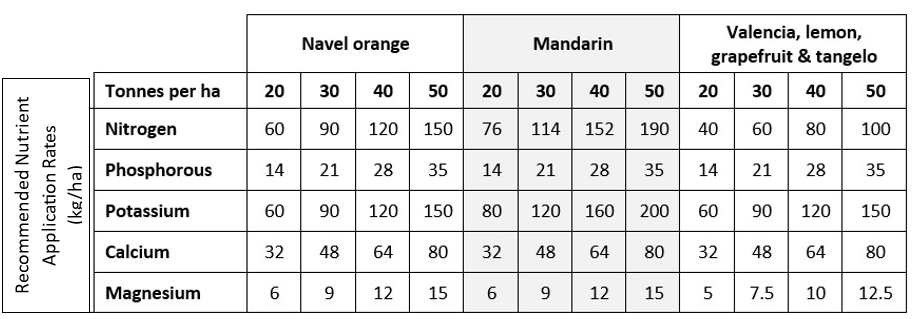
Timing for Fertiliser Application
Timing is important for citrus fertiliser programs, as the trees require different nutrients at different stages. For example, as we enter spring, citrus trees will need nitrogen, phosphorus and potassium to support root and leaf growth and encourage fruit set. Table 2 is an example of the key nutrients required by crop growth stage.
Table 2: Nutrient application times as a percentage of annual application.

* If fertigation is used.
Source: Department of Primary Industries and Regional Development WA. (www.agric.wa.gov.au/citrus/citrus-nutrition)
Budding to Flowering and Fruit Set (August to October)
During budding, flowering and fruit set, the citrus tree needs nitrogen to maintain leaf growth and boost tree reserves for better fruit set. At this stage, 40-50% of the nitrogen fertiliser planned for the year needs to be applied. This is usually done in two applications, with the first made at bud swell and the second at spring flush. This is the stage when phosphorus is applied to promote early root formation and growth. If using a granular phosphorus fertiliser, such as MAP, it can all be applied at this growth stage. It is also when 30-40% of the annual potassium requirement is applied. Potassium is important for fruit quality, size, appearance, colour, soluble solids, acidity and vitamin contents (Kumar et al 2006).
To ensure a balanced nutrient supply, a combination of NPKS (nitrogen, phosphorus, and potassium) and trace elements should be applied during the months of September and October. In places where nitrogen leaching can be a prevalent issue, apply eNpower + EASY N, which offers a specialised formulation that minimises nitrogen loss. eNpower is an effective ammonium stabiliser that inhibits the leaching process and slows down nitrification so the nitrogen will remain in the soil available to the plant.
It is also essential to monitor micronutrient levels with tissue tests in summer (January to February), particularly:
- Zinc – important to promote strong, uniform bud burst, fruit set, retention, and sizing.
- Magnesium – involved in the export of carbohydrates from source to sink sites and has been shown to increase fruit weight through increased juice content.
- Boron – has a role in cell wall structure and integrity, while molybdenum plays a role in nitrogen metabolism.
- Iron – plays a role in respiration, photosynthesis and is a cofactor in many enzymes.
Consult the Sampling Guides | Nutrient Advantage to get the best results from your citrus leaf samples.
Easy Liquids offer a convenient solution with their KEYPRO TRACE product, which consolidates all necessary trace elements into a single product. By using this product, you can ensure the continuous availability of vital micronutrients, keeping your trace elements in balance and optimising plant health.
Liquid Trigger plus Easy N is an option for citrus crops, particularly where they are grown in sandy soils with a low cation exchangeable capacity (CEC). Liquid Trigger may improve nutrient use efficiency and overall soil health.
Leaf Testing Results and Insights from Nutrient Advantage
Understanding citrus plant nutritional status during the growing season is critical to managing and making informed decisions for your individual orchard scenario. In recent years, leaf samples taken during summer season in citrus orchards, and tested at the Nutrient Advantage® laboratory, showed the following results:
- 44% samples low in N
- 10% Low in S
- 17% Low in Ca
- 07% Low in Mg
- 24% Low in Cu
- 68% Low in Zn
- 51% Low in Mn
Early Fruit Growth (November to December)
By early fruit growth, the tree has been through a rapid period of vegetative growth and the fruit are set. At this point, more nitrogen should be applied – generally about 25% of the annual nitrogen requirement.
Potassium is needed after the fruit reaches 10 mm in size. Around 30-50% of the total annual potassium requirement can be applied at this time, with the rest added later in the fruit growth period.
Applying soluble calcium can help to prevent fruit deformations such as creasing, cracking and splitting in the rind, which can downgrade the produce.
To effectively monitor the requirement for essential micronutrients like magnesium, manganese, and zinc, it is recommended to use tissue testing. With the new range of Easy Liquids foliar products, any micronutrient deficiencies can be corrected.
Fruit Growth (January to April)
When the fruit is actively growing, the demand for nitrogen, potassium and calcium is high. It is at this point that the last quarter of the annual nitrogen requirement can be applied. Nitrogen applied during this time will also help ensure adequate carbohydrate reserves for next season’s flowering.
This is also a key time for potassium application, with up to 30% of the annual requirement needed after the fruit drop stage in January or February.
During the crucial stage of fruit growth, ensuring the quality of citrus crops is essential. To provide the necessary nitrogen and calcium nutrients, Easy Liquids offers a variety of effective liquid solutions in their N Cal formulations. Calcium remains particularly important at this growth stage for protecting crop quality.
Soil Analysis Interpretation for Citrus
A soil test was conducted on a citrus farm located in the Waikerie region in South Australia during the third year of Navel crop growth.
Table 3. Soil Analysis Report
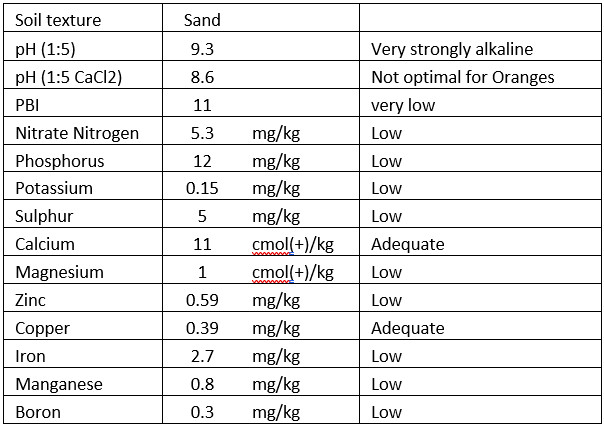
The soil analysis revealed significant deficiencies in both micro and macronutrients, indicating a calcareous soil with a high pH level. Considering these findings, it is crucial to develop a comprehensive fertiliser plan that can not only improve yield but maximise the genetic potential of the crop while ensuring efficient nutrient application.
Before recommending a fertiliser program, it is crucial to determine the available amount of nutrients per hectare and understand nutrient rates based on yield.
Incorporating granule and liquid products into the fertiliser plan can address nutrient deficiencies effectively and provide the crop with the necessary nutrition to maximise yield and overall crop quality. As an example, Table 4 shows a fertiliser program using both granules and liquid products.
Table 4: Suggested products and key application timing.

Note: Individual rates will be based on yield and soil test values. Talk to your agronomist before deciding on your program.
Further Information
For more information on fertiliser programs for citrus crops, feel free to contact me at natalia.gomez@incitecpivot.com.au or +61 427 232 982.
Also consult the Sampling Guides | Nutrient Advantage
References
Ramesh Kumar A, Kumar N and Kavino M (2006) ‘Role of potassium in fruit crops – a review’. Agric. Rev. 27 (4): 284-291.
Bevington K, Hardy S, Melville P, Thiel K, Fullelove G and Morrish P (2003) ‘The Fruit Size Management Guide Part 1’. Compiled by Australian Citrus Growers https://citrusaustralia.com.au//www/wp-content/uploads/Key-elements-of-nutrition-for-fruit-size.pdf
Lacey K (2019) ‘Citrus nutrition’. https://www.agric.wa.gov.au/citrus/citrus-nutrition
DISCLAIMER
This is a guide only, which we hope you find useful as a general tool. Incitec Pivot Fertilisers manufactures and sources fertilisers from other suppliers, and the fertiliser supply chain extends beyond the company’s direct control, both overseas and within Australia. While Incitec Pivot Fertilisers has taken all reasonable care in the preparation of this guide, it should not be relied on as a substitute for tailored professional advice, and Incitec Pivot Fertilisers accepts no liability in connection with this guide.
You might also be interested in these

Horticulture
Delivered and ready to use: The many benefits of liquid fertiliser
August / 2023
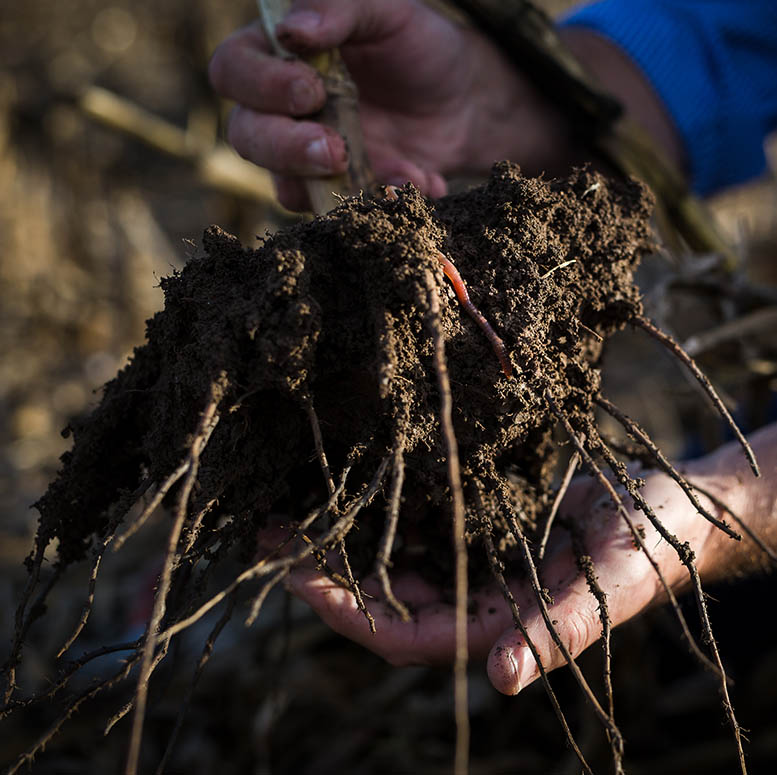
Horticulture, Pasture, Sugar, Summer Crop
Poor Soil Structure – Have you identified if it is costing you profitability?
November / 2023
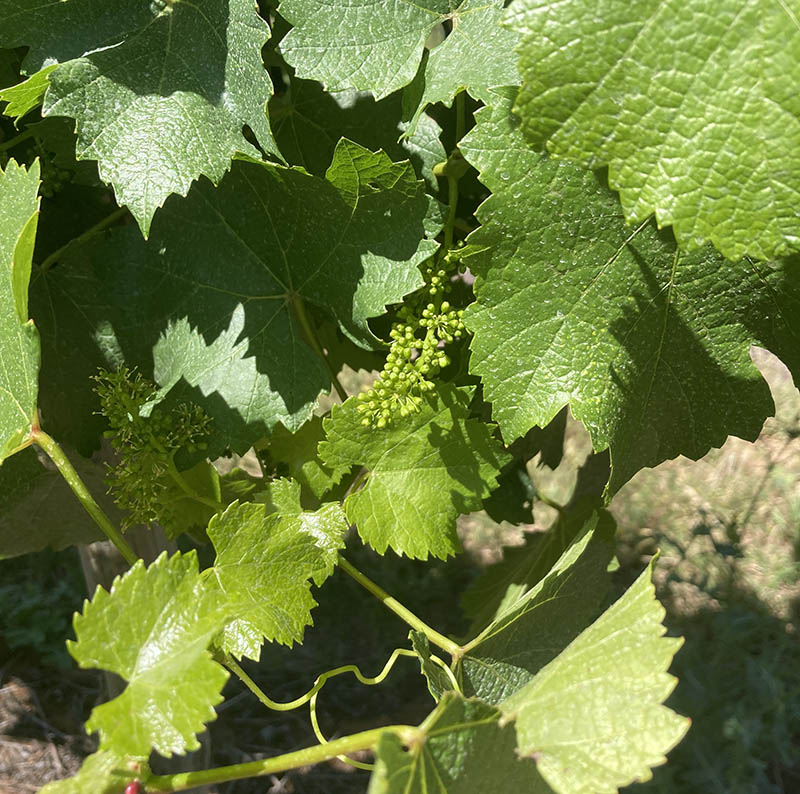
Horticulture
The power of the petiole test
October / 2023

Summer Crop
Phosphorus and Zinc: Key to establishing crops
September / 2023

